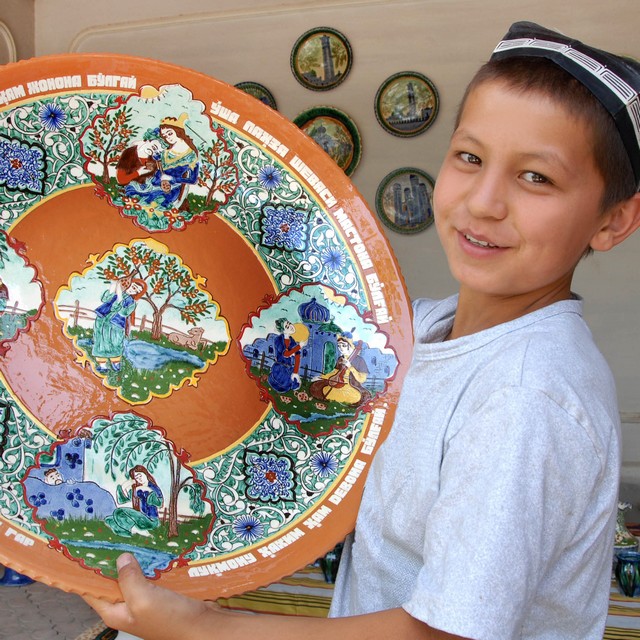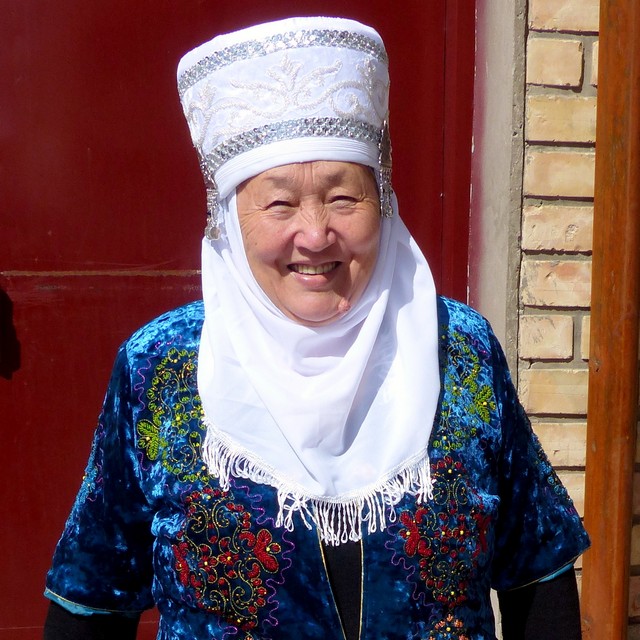Enjoy a full day exploring some of Bukhara's main highlights, including the Lab-i-Khauz Ensemble, the Nadirkhon Devanbegi Madrasah and the Mogaki Attari Mosque. Also see the Poi Kalon minaret and mosque before proceeding to the Aziz Khan and Ulug Beg Madrasahs. After lunch, visit Ark Fortress, Balakhauz Mosque, the Mausoleum of Ismail Samani, and Chashma Ayub. Continue to the Hunarmand UNDP Assisted Workshops near Lyabikhauz, and observe block printing, carving and suzani embroidery. Overnight in Bukhara.
Overnight in Paradise Plaza, Bukhara
Meal plan: Breakfast
UNESCO-listed Bukhara was a key staging point on the Silk Road. According to myth the city was founded by a Persian prince who escaped his wicked stepmother across the Oxus river in search of new fortunes . The city today is home to over 140 largely intact architectural monuments. Constructed on an artificial hill in the 5th century BC, the Ark Fortress is Bukhara’s oldest building. The former military structure became the winter residence of Bukhara’s emirs before it fell under rule of Russia in 1920. Besides an edifying visiti to the Ark Museum, the Fortress houses the former Russian Embassy, the former home of a progressive vizier named Kush Begi, and the throne room, where emirs were coronated and coins were minted.
The Ark Fortress is Bukhara’s oldest building, constructed on an artificial hill in the 5th century BC. The former military structure became the winter residence of Bukhara’s emirs, before it fell under rule of Russia in 1920. Today, the Ark is home to a museum that depicts its history and you can visit the former Russian Embassy, the former home of a progressive vizier named Kush Begi, and the throne room, where emirs were coronated and coins were minted.
Chashma Ayub, means “Job's well”. To combat drought in the region, Job (of Biblical fame) struck the ground with his staff and made a well. The water of this miraculous well is still believed to possess healing powers. A mausoleum was later constructed to protect the sacred site, and there is a small water museum here too.
The Mausoleum of Ismail Samani was built at the end of the 9th century, making it one of Bukhara’s oldest buildings. It was constructed by Ismail Samani as a family crypt following the death of his father. Ismail was the founder of the Samanid dynasty, and his reign was seen as Bukhara’s first golden age during which education and the arts flourished. The mausoleum’s simple architectural design is decorated with geometrically intricate patterns made from fired mud brick and shows influences of Buddhism as well as Islam, making the mausoleum unique.
Balakhauz mosque is the only preserved monument on the Registan square in Bukhara. The building was constructed in 1712 under the rule of Emir Shakhmurad. It was primarily built for public prayers, but was also a dormitory for Dervishes. Its beautiful wooden pillars are made from elm, walnut and poplar.
Poi Kalyan is a religious site that encompasses Kalan Minaret, Kalan Mosque and the Mir-i- Arab Madrassah. Kalyan Minaret, which stands at around 46.5m high, was built in 1127. It’s often called the "Tower of Death", as during the reign of Emir Nasrullah – the Butcher of Bukhara - many of those sentenced to death were thrown from the top. Kalyan Mosque was built during the 1500s, on the site of a former mosque that had been destroyed by Genghis Khan. Modelled on Naqsh-e-Jahan square in Isfahan in Iran and built by Persian craftsmen, it served as a warehouse during Soviet rule. The ornate Mir-i Arab Madrassa was built by Ubaidullah-khan in honour of his spiritual mentor, Sheikh Abdullah Yamani of Yemen. A great blue dome stands above the intricate murals that adorn the great entrance.
The Ulug Beg Madrasah is part of Kosh Madrasah, which also includes the Aziz Khan Madrasah. Each of these structures represent different ruling dynasties in the history of Bukhara. The influence of the Timurid and Ashtarkanid dynasties is reflected in the madrasah's differing architectural design and decor - where the Ulug beg Madrasah is more modest, Aziz Khan is more luxurious.
The Nadirkhon Devanbegi Khana was built in 1620 as a lodging house for Sufi Muslims. Due to its location, the Khana became a significant cultural and religious site in Bukhara. Following the construction of the Nadirkhon Devanbegi Khana the connecting Madrasah was then built in 1962 - both under the order of Vizier Nadir. Its architecture is typical of Central Asian Muslim monuments, whilst the decor features colourful murals of birds, animals, the sun and human beings - something that was uncharacteristic of Islamic monuments constructed during this era.
The Lab-i-Khauz Ensemble means "by the pond" in Persian. It is the name given to the architectural monuments that surround one of the few remaining ponds in the city of Bukhara. Many others were filled during the Soviet era due to fears of spreading disease. This one remains and is the centerpiece of a remarkable architectural ensemble including the Kujeldash Madrassa (built in 1568-1569), the Nadikhon Devanbegi Madrassa (1620) and Khana (1622). There has been a tea house beside the pond since the 16th century and Bukhara’s Jewish quarter abuts this area.
Hunarmand Assisted Workshops were established under the supervision of the United Nations Development Programme with the intention to support the development of local handicrafts. Visitors to the workshops can watch the skilled process of suzani embroidery (traditional Uzbek tapestries). Other crafts practiced here include block printing, metal chasing, carving and miniature painting








































